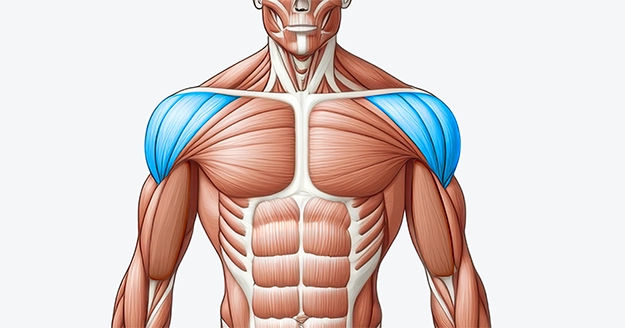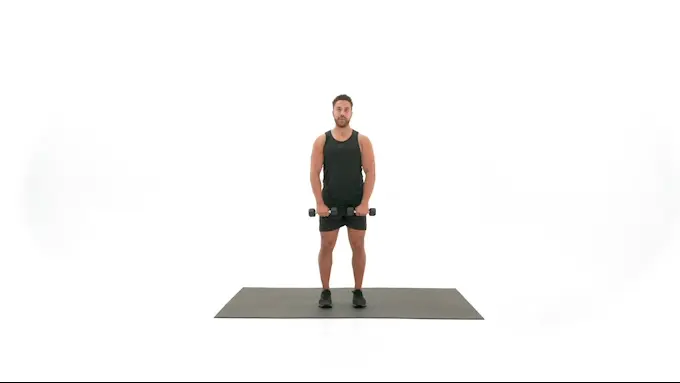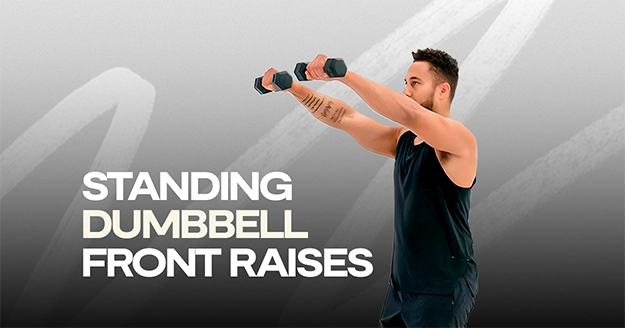Exercise Profile
Standing Dumbbell Front Raises Overview
The Standing Dumbbell Front Raise, or simply Dumbbell Front Raise, is an essential shoulder exercise that works the front deltoids while also exercising the upper chest. Suitable for all fitness levels, it’s effective with light to moderate weights, making it a valuable addition to beginner and advanced workout programs.
The Standing Dumbbell Front Raise is an excellent, simple exercise for beginners to develop shoulder strength. You can increase the intensity of your front deltoids exercise as you go by varying the tempo or increasing weight. This makes it a versatile exercise for beginners and advanced athletes looking to improve shoulder definition and upper body strength.
Standing Dumbbell Front Raises can be easily integrated into various workout routines. They work well as a warm-up for shoulder-focused workouts, can be included in full-body circuits to improve shoulder endurance, or serve as part of your upper-body training to enhance strength and definition. This standing dumbbell front raises guide will help you maximize this effective exercise.

Standing Dumbbell Front Raises Instructions
Step 1: Dumbbells should be held in front of your thighs for an overhand grip. For a neutral and underhand grip, hold them at your sides.
Step 2: Keep a slight bend in your elbows throughout the movement and keep a soft lock in your knees.
Step 3: Raise both arms out front until the dumbbells go past your forehead. Avoid bringing the weights completely overhead to keep tension in your front delts.
Step 4: With control, lower the dumbbells and feel the contraction in your front delts. Avoid letting the weights rest or bounce off your thighs to start the next rep.

Common Standing Dumbbell Front Raises Variations
Dumbbell front raises are a staple for shoulder training, but you can mix things up with variations to adjust the intensity or target specific muscles. Try these well-liked versions, which include:
Standing Dumbbell Front Raises Tips
- Stand tall with your feet shoulder-width apart. To stay stable during the exercise, keep your back straight and contract your core muscles.
- Lift the dumbbells slowly and with control. Concentrate on using your shoulder muscles to raise the weights rather than swinging or applying momentum.
- Throughout the exercise, maintain a small bend in your arms. This helps reduce strain on the joints and ensures that the emphasis stays on the deltoids.
- Breathe out when you raise the weights and in when you bring them down. Maintaining a steady breathing pattern helps improve your performance and endurance.
Standing Dumbbell Front Raises Common Mistakes
- Using Excessive Weight: Lifting too heavy might result in bad form and raise the possibility of injury. Pick a weight that lets you execute the exercise with good form and control.
- Swinging the Weights: When dumbbells are lifted with momentum rather than deliberate movement, the exercise loses its effectiveness and puts too much strain on the shoulders. Focus on a slow, steady pace.
- Improper Arm Position: Shoulder joint tension might result from lifting weights too high or from letting your arms hang freely. For best form, elevate the dumbbells only to shoulder height with your elbows slightly bent.
Frequently Asked Questions
Is it possible to do dumbbell lateral raises as a variation?
Yes, you can do dumbbell lateral raises as a variation. While front raises emphasize the front deltoids, lateral raises concentrate on the side deltoids to enhance overall shoulder strength and definition. Mixing both in your routine offers balanced shoulder training.
Which kind of raises—front or lateral—is preferable?
It depends on your goals. Lateral raises target the side deltoids for shoulder width, while front raises focus on the front deltoids. Using both in your routine provides balanced shoulder development.
Is it safe to lift weights on an empty stomach?
Yes, it’s generally fine to lift weights on an empty stomach, as some find it helps with fat burning and focus. However, if you feel weak or lightheaded, consider having a small snack beforehand.
Are front raises the most effective exercise for your front deltoids?
Although they might not be the greatest or only exercise, front rises are a useful tool for strengthening the front deltoids. Including a range of exercises can help build balanced shoulder growth and general strength, such as lateral raises and shoulder presses.
Can standing front dumbbell cause shoulder pain?
Front raises can cause shoulder pain if done with poor form or too much weight. Use a controlled motion and appropriate weight, and if you feel pain, adjust your technique or consult a professional.
Post your post-workout selfies in IG and tag @trainestapp, #trainest, or DM them to us to get a shoutout on Trainest Stories!


